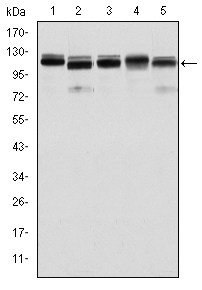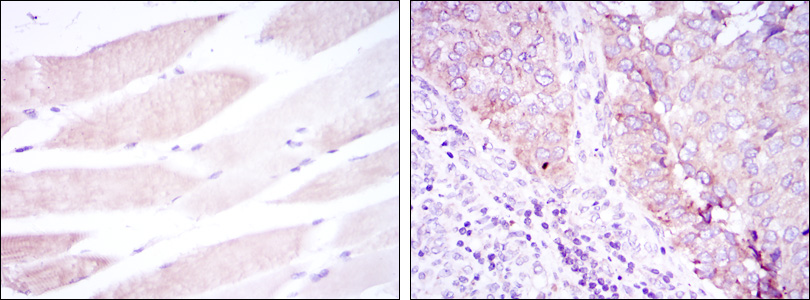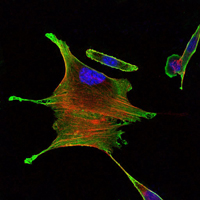BMPR-II Monoclonal Antibody
- Catalog No.:YM0075
- Applications:WB;IHC;IF;ELISA
- Reactivity:Human;Mouse;Rat;Monkey
- Target:
- BMPR-II
- Fields:
- >>Cytokine-cytokine receptor interaction;>>TGF-beta signaling pathway;>>Axon guidance;>>Hippo signaling pathway;>>Signaling pathways regulating pluripotency of stem cells;>>MicroRNAs in cancer;>>Fluid shear stress and atherosclerosis
- Gene Name:
- BMPR2
- Protein Name:
- Bone morphogenetic protein receptor type-2
- Human Gene Id:
- 659
- Human Swiss Prot No:
- Q13873
- Mouse Gene Id:
- 12168
- Mouse Swiss Prot No:
- O35607
- Immunogen:
- Purified recombinant fragment of human BMPR-II expressed in E. Coli.
- Specificity:
- BMPR-II Monoclonal Antibody detects endogenous levels of BMPR-II protein.
- Formulation:
- Liquid in PBS containing 50% glycerol, 0.5% BSA and 0.02% sodium azide.
- Source:
- Monoclonal, Mouse
- Dilution:
- WB 1:500 - 1:2000. IHC 1:200 - 1:1000. IF 1:200 - 1:1000. ELISA: 1:10000. Not yet tested in other applications.
- Purification:
- Affinity purification
- Storage Stability:
- -15°C to -25°C/1 year(Do not lower than -25°C)
- Other Name:
- BMPR2;PPH1;Bone morphogenetic protein receptor type-2;BMP type-2 receptor;BMPR-2;Bone morphogenetic protein receptor type II;BMP type II receptor;BMPR-II
- Molecular Weight(Da):
- 115kD
- References:
- 1. J Heart Lung Transplant. 2008 Jun;27(6):668-74.
2. Genet Med. 2008 May;10(5):359-65.
- Background:
- This gene encodes a member of the bone morphogenetic protein (BMP) receptor family of transmembrane serine/threonine kinases. The ligands of this receptor are BMPs, which are members of the TGF-beta superfamily. BMPs are involved in endochondral bone formation and embryogenesis. These proteins transduce their signals through the formation of heteromeric complexes of two different types of serine (threonine) kinase receptors: type I receptors of about 50-55 kD and type II receptors of about 70-80 kD. Type II receptors bind ligands in the absence of type I receptors, but they require their respective type I receptors for signaling, whereas type I receptors require their respective type II receptors for ligand binding. Mutations in this gene have been associated with primary pulmonary hypertension, both familial and fenfluramine-associated, and with pulmonary venoocclusive disea
- Function:
- catalytic activity:ATP + [receptor-protein] = ADP + [receptor-protein] phosphate.,cofactor:Magnesium or manganese.,disease:Defects in BMPR2 are a cause of pulmonary venoocclusive disease (PVOD) [MIM:265450]. PVOD is a rare form of pulmonary hypertension in which the vascular changes originate in the small pulmonary veins and venules. The pathogenesis is unknown and any link with PPH1 has been speculative. The finding of PVOD associated with a BMPR2 mutation reveals a possible pathogenetic connection with PPH1.,disease:Defects in BMPR2 are the cause of primary pulmonary hypertension (PPH1) [MIM:178600]. PPH1 is a rare autosomal dominant disorder characterized by plexiform lesions of proliferating endothelial cells in pulmonary arterioles. The lesions lead to elevated pulmonary arterial pression, right ventricular failure, and death. The disease can occur from infancy throughout life and i
- Subcellular Location:
- Cell membrane ; Single-pass type I membrane protein.
- Expression:
- Highly expressed in heart and liver.
- June 19-2018
- WESTERN IMMUNOBLOTTING PROTOCOL
- June 19-2018
- IMMUNOHISTOCHEMISTRY-PARAFFIN PROTOCOL
- June 19-2018
- IMMUNOFLUORESCENCE PROTOCOL
- September 08-2020
- FLOW-CYTOMEYRT-PROTOCOL
- May 20-2022
- Cell-Based ELISA│解您多样本WB检测之困扰
- July 13-2018
- CELL-BASED-ELISA-PROTOCOL-FOR-ACETYL-PROTEIN
- July 13-2018
- CELL-BASED-ELISA-PROTOCOL-FOR-PHOSPHO-PROTEIN
- July 13-2018
- Antibody-FAQs
- Products Images

- Western Blot analysis using BMPR-II Monoclonal Antibody against HeLa (1), A431 (2), NIH/3T3 (3), Cos7 (4) and PC-12 (5) cell lysate.

- Immunohistochemistry analysis of paraffin-embedded muscle tissues (left) and kidney cancer tissues (right) with DAB staining using BMPR-II Monoclonal Antibody.

- Immunofluorescence analysis of Eca109 cells using BMPR-II Monoclonal Antibody (green). Blue: DRAQ5 fluorescent DNA dye. Red: Actin filaments have been labeled with Alexa Fluor-555 phalloidin.




